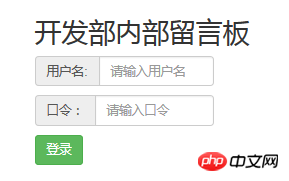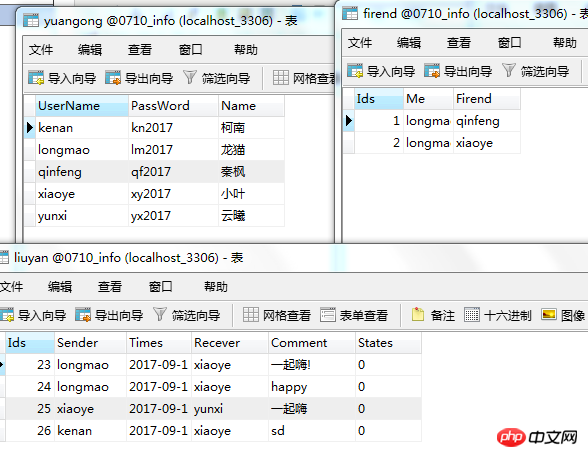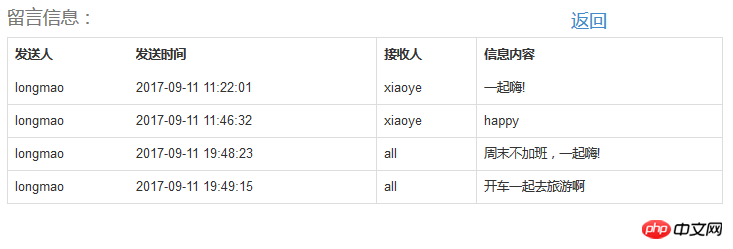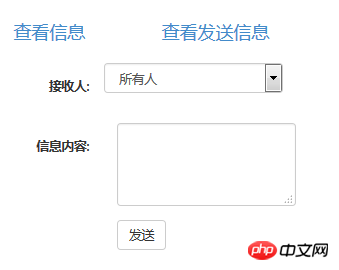使用PHP連線資料庫實作留言板功能
下面小編就為大家帶來一篇使用PHP連線資料庫實作留言板功能的實例講解(推薦)。小編覺得蠻不錯的,現在就分享給大家,也給大家做個參考。一起跟著小編過來看看吧
PHP實作留言板功能:
1 首先是登入頁面:
<!DOCTYPE html>
<html>
<head>
<meta charset="UTF-8">
<title>留言板登录</title>
<script src="bootstrap/js/jquery-1.11.2.min.js"></script>
<script src="bootstrap/js/bootstrap.min.js"></script>
<link href="bootstrap/css/bootstrap.min.css" rel="external nofollow" rel="external nofollow" rel="external nofollow" rel="stylesheet" type="text/css"/>
</head>
<style>
.header{
margin-left: 550px;
margin-top: 150px;
height: 300px;
max-width: 300px;
}
.xiugai{
max-width: 200px;
}
.login{
margin-top: 10px;
}
</style>
<body>
<form action="messloginchuli.php" method="post">
<p class="header">
<h2>开发部内部留言板</h2>
<p class="input-group xiugai">
<span class="input-group-addon" >用户名:</span>
<input type="text" class="form-control" name="uid" placeholder="请输入用户名">
</p>
<p class="input-group xiugai" >
<span class="input-group-addon">口令:</span>
<input type="text" class="form-control" name="pwd" placeholder="请输入口令">
</p>
<button type="submit" class="btn btn-success login">登录</button>
</p>
</form>
</body>
</html>2 登入頁面完成後要進入登入處理頁面了,也就是上面提交到的messloginchuli.php
<?php
session_start(); // 登录之后要把所包含登录的页面连接起来,开启session
$uid = $_POST["uid"];
$pwd = $_POST["pwd"];
require_once "./DBDA.class.php";
$db = new DBDA();
$sql = "select password from yuangong where username='{$uid}'";
$arr = $db->query($sql,0);
//var_dump($arr[0][0]);
if($arr[0][0]=$pwd && !empty($pwd)){
$_SESSION["uid"]=$uid;
header("location:message.php");
}
?>登入頁面效果如圖:

#3.登入完成後是進入首頁面,也就是顯示自己收到的對話內容,以下是設計的資料庫的表格和主頁面的程式碼:

<!DOCTYPE html>
<html>
<head>
<meta charset="UTF-8">
<title></title>
<script src="bootstrap/js/jquery-1.11.2.min.js"></script>
<script src="bootstrap/js/bootstrap.min.js"></script>
<link href="bootstrap/css/bootstrap.min.css" rel="external nofollow" rel="external nofollow" rel="external nofollow" rel="stylesheet" type="text/css"/>
</head>
<style>
.mess{
max-width: 800px;
margin-left: 250px;
margin-top: 150px;
}
</style>
<body>
<?php
session_start();
$uid = $_SESSION["uid"];
if(empty($_SESSION["uid"])){
header("location:messlogin.php");
exit;
}
?>
<p >
<a href="publish_info.php" rel="external nofollow" >发布信息</a>
<a href="tuichuchuli.php" rel="external nofollow" >退出系统</a>
</p>
<table class="table table-bordered mess" >
<caption >
留言信息:
</caption>
<thead>
<tr>
<th>发送人</th>
<th>发送时间</th>
<th>接收人</th>
<th>信息内容</th>
</tr>
</thead>
<tbody>
<?php
require_once "./DBDA.class.php";
$db = new DBDA();
$sql = "select * from liuyan where recever='{$uid}' or recever='all'";
$arr = $db->query($sql,0);
foreach($arr as $v){
echo "<tr>
<td>{$v[1]}</td>
<td>{$v[2]}</td>
<td>{$v[3]}</td>
<td>{$v[4]}</td>
</tr>";
}
?>
</tbody>
</table>
</body>
</html>退出登入系統實現使用者登出,返回登入頁面功能代碼如下:
<?php
session_start();
$uid = $_SESSION["uid"];
unset($uid);
header("location:messlogin.php");
?>程式碼寫到這裡,比較重要的部分就完成了,在下面是要進入發布資訊頁面了,相當於之前寫的添加的頁面,其處理頁面也是和之前沒什麼區別的,差別在於現在的處理頁面是在用戶登錄的情況下操作的,需要用session把所有的登錄情況下的頁面連接起來
主頁面效果如圖:



#4.最後是訊息發布頁面,可以傳送訊息
##代碼如下:
<!DOCTYPE html>
<html>
<head>
<meta charset="UTF-8">
<title>发布信息界面</title>
<script src="bootstrap/js/jquery-1.11.2.min.js"></script>
<script src="bootstrap/js/bootstrap.min.js"></script>
<link href="bootstrap/css/bootstrap.min.css" rel="external nofollow" rel="external nofollow" rel="external nofollow" rel="stylesheet" type="text/css"/>
</head>
<style>
.mess{
max-width: 200px;
margin-top: 10px;
}
.mess1{
margin-top: 10px;
}
.opt{
max-width: 200px;
margin-left: 80px;
}
.txt{
max-width: 200px;
}
</style>
<body>
<?php
session_start();
$uid = $_SESSION["uid"];
if (empty($_SESSION["uid"])) {
header("location:messlogin.php");
exit ;
}
?>
<p >
<p >
<a href="message.php" rel="external nofollow" >查看信息</a>
<a href="seemess.php" rel="external nofollow" >查看发送信息</a>
</p>
<form class="form-horizontal" role="form" action="infochuli.php" method="post">
<p class="form-group">
<label for="firstname" class="col-sm-2 control-label mess1">接收人:</label>
<p class="form-group ">
<select class="form-control opt" name="recever">
<option value="all">所有人</option>
<?php
require_once "./DBDA.class.php";
$db = new DBDA();
//这里可以给特定的朋友发送信息的sql语句
//$sql = "select firend.firend,yuangong.name from firend,yuangong where firend.firend
//= yuangong.username and firend.me = '{$uid}'";
$sname = "select * from yuangong where username not in ('{$uid}')";
$arr = $db->query($sname,0);
//var_dump($arr[0][2]);
foreach($arr as $v){
echo "<option value='{$v[0]}'>{$v[2]}</option>";
}
?>
</select>
</p>
</p>
<p class="form-group">
<label for="lastname" class="col-sm-2 control-label mess1">信息内容:</label>
<p class="col-sm-10">
<textarea class="form-control txt" rows="3" name="content"></textarea>
</p>
</p>
<p class="form-group">
<p class="col-sm-offset-2 col-sm-10">
<button type="submit" class="btn btn-default">
发送
</button>
</p>
</p>
</form>
</p>
</body>
</html><?php
session_start();
$uid = $_SESSION["uid"];
$recever = $_POST["recever"];
$content = $_POST["content"];
$arr = $_POST["recever"];
$t = date("Y-m-d H:i:s");
require_once "./DBDA.class.php";
$db = new DBDA();
$sql = "insert into liuyan values('','{$uid}','{$t}','{$recever}','{$content}',0)";
$arr = $db->query($sql);
if($arr && !empty($arr)){
header("location:publish_info.php");
}else{
echo "发送失败!";
}
?>以上是使用PHP連線資料庫實作留言板功能的詳細內容。更多資訊請關注PHP中文網其他相關文章!

熱AI工具

Undresser.AI Undress
人工智慧驅動的應用程序,用於創建逼真的裸體照片

AI Clothes Remover
用於從照片中去除衣服的線上人工智慧工具。

Undress AI Tool
免費脫衣圖片

Clothoff.io
AI脫衣器

Video Face Swap
使用我們完全免費的人工智慧換臉工具,輕鬆在任何影片中換臉!

熱門文章

熱工具

記事本++7.3.1
好用且免費的程式碼編輯器

SublimeText3漢化版
中文版,非常好用

禪工作室 13.0.1
強大的PHP整合開發環境

Dreamweaver CS6
視覺化網頁開發工具

SublimeText3 Mac版
神級程式碼編輯軟體(SublimeText3)
 PHP和Python:比較兩種流行的編程語言
Apr 14, 2025 am 12:13 AM
PHP和Python:比較兩種流行的編程語言
Apr 14, 2025 am 12:13 AM
PHP和Python各有優勢,選擇依據項目需求。 1.PHP適合web開發,尤其快速開發和維護網站。 2.Python適用於數據科學、機器學習和人工智能,語法簡潔,適合初學者。
 mysql:簡單的概念,用於輕鬆學習
Apr 10, 2025 am 09:29 AM
mysql:簡單的概念,用於輕鬆學習
Apr 10, 2025 am 09:29 AM
MySQL是一個開源的關係型數據庫管理系統。 1)創建數據庫和表:使用CREATEDATABASE和CREATETABLE命令。 2)基本操作:INSERT、UPDATE、DELETE和SELECT。 3)高級操作:JOIN、子查詢和事務處理。 4)調試技巧:檢查語法、數據類型和權限。 5)優化建議:使用索引、避免SELECT*和使用事務。
 PHP:網絡開發的關鍵語言
Apr 13, 2025 am 12:08 AM
PHP:網絡開發的關鍵語言
Apr 13, 2025 am 12:08 AM
PHP是一種廣泛應用於服務器端的腳本語言,特別適合web開發。 1.PHP可以嵌入HTML,處理HTTP請求和響應,支持多種數據庫。 2.PHP用於生成動態網頁內容,處理表單數據,訪問數據庫等,具有強大的社區支持和開源資源。 3.PHP是解釋型語言,執行過程包括詞法分析、語法分析、編譯和執行。 4.PHP可以與MySQL結合用於用戶註冊系統等高級應用。 5.調試PHP時,可使用error_reporting()和var_dump()等函數。 6.優化PHP代碼可通過緩存機制、優化數據庫查詢和使用內置函數。 7
 PHP行動:現實世界中的示例和應用程序
Apr 14, 2025 am 12:19 AM
PHP行動:現實世界中的示例和應用程序
Apr 14, 2025 am 12:19 AM
PHP在電子商務、內容管理系統和API開發中廣泛應用。 1)電子商務:用於購物車功能和支付處理。 2)內容管理系統:用於動態內容生成和用戶管理。 3)API開發:用於RESTfulAPI開發和API安全性。通過性能優化和最佳實踐,PHP應用的效率和可維護性得以提升。
 什麼是跨站點偽造(CSRF),您如何在PHP中實施CSRF保護?
Apr 07, 2025 am 12:02 AM
什麼是跨站點偽造(CSRF),您如何在PHP中實施CSRF保護?
Apr 07, 2025 am 12:02 AM
在PHP中可以通過使用不可預測的令牌來有效防範CSRF攻擊。具體方法包括:1.生成並在表單中嵌入CSRF令牌;2.在處理請求時驗證令牌的有效性。
 PHP與Python:了解差異
Apr 11, 2025 am 12:15 AM
PHP與Python:了解差異
Apr 11, 2025 am 12:15 AM
PHP和Python各有優勢,選擇應基於項目需求。 1.PHP適合web開發,語法簡單,執行效率高。 2.Python適用於數據科學和機器學習,語法簡潔,庫豐富。
 PHP的目的:構建動態網站
Apr 15, 2025 am 12:18 AM
PHP的目的:構建動態網站
Apr 15, 2025 am 12:18 AM
PHP用於構建動態網站,其核心功能包括:1.生成動態內容,通過與數據庫對接實時生成網頁;2.處理用戶交互和表單提交,驗證輸入並響應操作;3.管理會話和用戶認證,提供個性化體驗;4.優化性能和遵循最佳實踐,提升網站效率和安全性。
 PHP的未來:改編和創新
Apr 11, 2025 am 12:01 AM
PHP的未來:改編和創新
Apr 11, 2025 am 12:01 AM
PHP的未來將通過適應新技術趨勢和引入創新特性來實現:1)適應云計算、容器化和微服務架構,支持Docker和Kubernetes;2)引入JIT編譯器和枚舉類型,提升性能和數據處理效率;3)持續優化性能和推廣最佳實踐。






